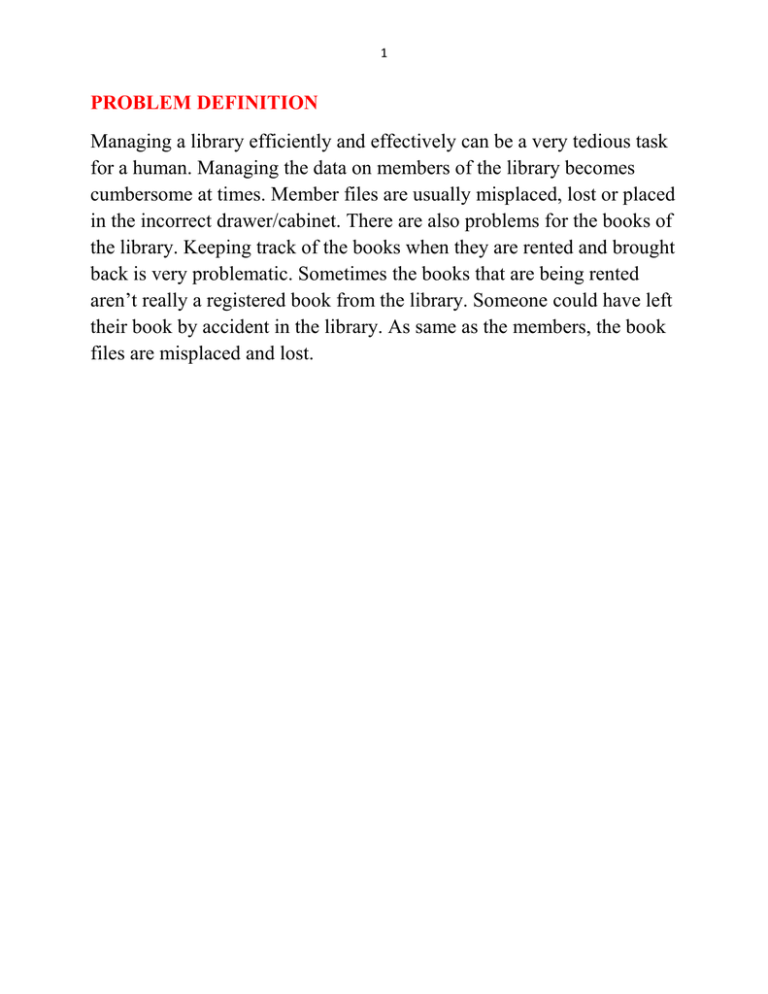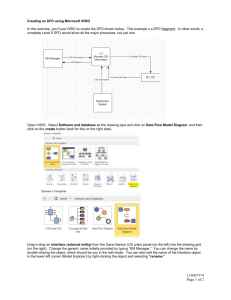book/s data
advertisement

1 PROBLEM DEFINITION Managing a library efficiently and effectively can be a very tedious task for a human. Managing the data on members of the library becomes cumbersome at times. Member files are usually misplaced, lost or placed in the incorrect drawer/cabinet. There are also problems for the books of the library. Keeping track of the books when they are rented and brought back is very problematic. Sometimes the books that are being rented aren’t really a registered book from the library. Someone could have left their book by accident in the library. As same as the members, the book files are misplaced and lost. 2 AIM To rebuild an existing program for the problem using software engineering techniques. To accept and store data that can be retrieved in the future when needed. Data will be kept up to date with the books that are being borrowed and returned from and to the Library. It also keep track on members when they take out or bring back books and any updates on their profile. 3 DATA FLOW DIAGRAM (DFD) – CONTEXT LEVEL (MEMBER/S DATA) Person’s data Person 0 Library System Member information Printer Member card Manager report Library Manager DATA FLOW DIAGRAM (DFD) – CONTEXT LEVEL (BOOK/S DATA) Book/s Book/s data 0 Library System Place book/s Manager report Library Manager Shelves 4 DATA FLOW DIAGRAM (DFD) – CONTEXT LEVEL (RENTING BOOKS) Book/s to rent 0 Member Book/s Library system Manager Report Library Manager DATA FLOW DIAGRAM (DFD) – CONTEXT LEVEL (RETURNING BOOKS & LATE FEES) Return book/s 0 Member Charge any late fee Return book/s Library System Manager report Library Manager Shelves 5 DATA FLOW DIAGRAM (DFD) – LEVEL 1 (MEMBER/S DATA) Person’s data 0.1 Person Receive Person’s Data Person’s data 0.3 0.2 Member’s card Transform person’s data to member card format Member card data Generate library member increment Adding Member data Member card data D1 Members File Printer Members data 0.4 Library Manager Manager report Generate Manager Report 6 DATA FLOW DIAGRAM (DFD) – LEVEL 1 (BOOK/S DATA) Book/s data 0.1 Book/s Receive Book/s data Book/s data 0.2 Transform data into book data format 0.3 Book data Generate library book increment Adding books data D1 Books File Books data 0.4 Library Manager Manager report Generate manager report 7 DATA FLOW DIAGRAM (DFD) – LEVEL 1 (RENTING BOOKS) Book/s renting 0.1 Member Receive book/s renting data Book rent data 0.2 Book/s rent data D1 Book/s rent file Set date due for book/s Book/s data 0.3 D2 Books File Library books data Generate library books decrements Daily Library books rented 0.4 Generate manager report Manager report Library manager 8 DATA FLOW DIAGRAM (DFD) – LEVEL 1 (RETURNING BOOKS & LATE FEES) Return book/s Member 0.1 Receive book/s data 0.6 Book/s data Books data D2 Books file Generate manager report 0.2 Check if date due late No books added data Manager report Yes 0.4 0.3 Calculate late fees Books data Generate library books increment Late fees D1 Late fees file Late fees 0.5 Generate late fee report Library manager late fees report 9 ENTITY RELATION DIAGRAM (ERD) Name M Person /s Becomes Phone number M Name Member ID Member /s M M Makes Book/s Type Name Address 1 Phone number Date due 1 Library Belong Book /s Book/s Return M Date due M Any late fees Book Rental Belong M Book/s name M M Type Book/s Contains Name Book ID 10 FUNCTIONAL AND NON-FUNCTIONAL REQUIREMENTS FUNCTIONAL REQUIREMENTS: This system will store and replace old data on books that come in and out of the library and members that join the library, rent and return books. This system will be able to calculate the late fees. NON-FUNCTIONAL REQUIREMENTS: This system will be more efficient from its last program. This system can run on any operating system.






